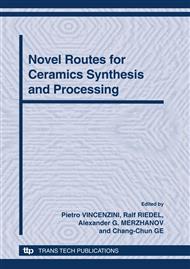p.332
p.340
p.348
p.352
p.358
p.364
p.370
p.374
p.383
Atomic and Electronic Structure of Zinc and Copper Pyrovanadates with Negative Thermal Expansion
Abstract:
Zinc and copper pyrovanadates are promising materials for micro- and optoelectronics due to their negative coefficient of volume thermal expansion (NTE). Besides, solid solutions on the base of these compounds can be used to obtain grade materials with variable thermal coefficients. Thermal deformation of both Zn2V2O7 and Cu2V2O7 structures was studied. According to the structural data, NTE of these substances is provided by the zigzag shape of zinc (copper) chains alongside with stable distances between layers. The structural and electronic characteristics depending on temperature were studied for α-Zn2V2O7 and α-Cu2V2O7 by using the first principle method. Our results demonstrate that the lowest total energies corresponds to the structural parameters at 400° C and 200° C for α-Zn2V2O7 and α-Cu2V2O7, respectively. We predict that α- Zn2V2O7 is a semiconductor with the band gap of 1,5 эВ and the bottom of conduction band is determined by the vanadium 3d states with small addition of antibonding oxygen 2р-states. For α- Cu2V2O7, the lowest interband transitions correspond to energy of 1,6 eV and involve also the O2p and V 3d states.
Info:
Periodical:
Pages:
358-363
Citation:
Online since:
October 2010
Price:
Сopyright:
© 2010 Trans Tech Publications Ltd. All Rights Reserved
Share:
Citation:


